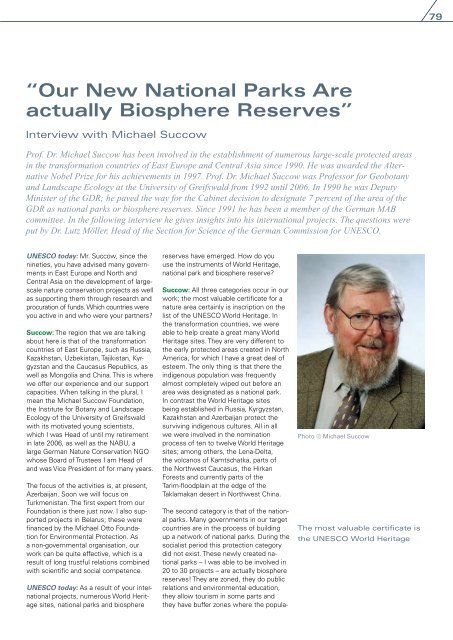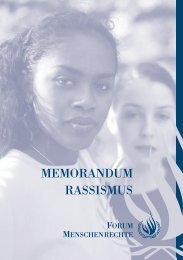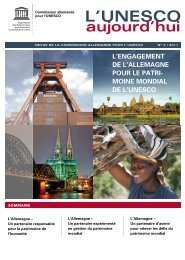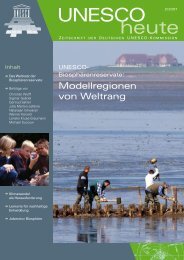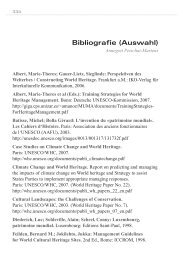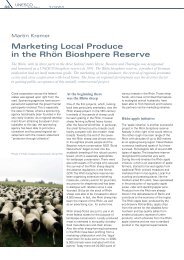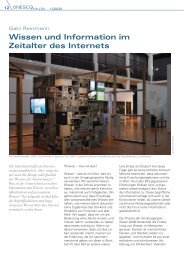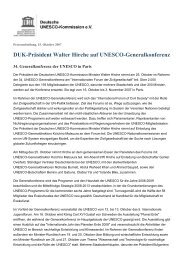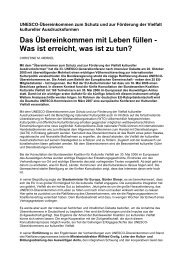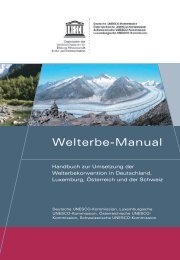Biosphere Reserves - UNESCO Deutschland
Biosphere Reserves - UNESCO Deutschland
Biosphere Reserves - UNESCO Deutschland
Create successful ePaper yourself
Turn your PDF publications into a flip-book with our unique Google optimized e-Paper software.
“Our New National Parks Are<br />
actually <strong>Biosphere</strong> <strong>Reserves</strong>”<br />
Interview with Michael Succow<br />
Prof. Dr. Michael Succow has been involved in the establishment of numerous large-scale protected areas<br />
in the transformation countries of East Europe and Central Asia since 1990. He was awarded the Alter-<br />
native Nobel Prize for his achievements in 1997. Prof. Dr. Michael Succow was Professor for Geobotany<br />
and Landscape Ecology at the University of Greifswald from 1992 until 2006. In 1990 he was Deputy<br />
Minister of the GDR; he paved the way for the Cabinet decision to designate 7 percent of the area of the<br />
GDR as national parks or biosphere reserves. Since 1991 he has been a member of the German MAB<br />
committee. In the following interview he gives insights into his international projects. The questions were<br />
put by Dr. Lutz Möller, Head of the Section for Science of the German Commission for <strong>UNESCO</strong>.<br />
<strong>UNESCO</strong> today: Mr. Succow, since the<br />
nineties, you have advised many governments<br />
in East Europe and North and<br />
Central Asia on the development of large-<br />
scale nature conservation projects as well<br />
as supporting them through research and<br />
procuration of funds. Which countries were<br />
you active in and who were your partners?<br />
Succow: The region that we are talking<br />
about here is that of the transformation<br />
countries of East Europe, such as Russia,<br />
Kazakhstan, Uzbekistan, Tajikistan, Kyrgyzstan<br />
and the Caucasus Republics, as<br />
well as Mongolia and China. This is where<br />
we offer our experience and our support<br />
capacities. When talking in the plural, I<br />
mean the Michael Succow Foundation,<br />
the Institute for Botany and Landscape<br />
Ecology of the University of Greifswald<br />
with its motivated young scientists,<br />
which I was Head of until my retirement<br />
in late 2006, as well as the NABU, a<br />
large German Nature Conservation NGO<br />
whose Board of Trustees I am Head of<br />
and was Vice President of for many years.<br />
The focus of the activities is, at present,<br />
Azerbaijan. Soon we will focus on<br />
Turkmenistan. The first expert from our<br />
Foundation is there just now. I also supported<br />
projects in Belarus; these were<br />
financed by the Michael Otto Foundation<br />
for Environmental Protection. As<br />
a non-governmental organisation, our<br />
work can be quite effective, which is a<br />
result of long trustful relations combined<br />
with scientific and social competence.<br />
<strong>UNESCO</strong> today: As a result of your international<br />
projects, numerous World Heritage<br />
sites, national parks and biosphere<br />
reserves have emerged. How do you<br />
use the instruments of World Heritage,<br />
national park and biosphere reserve?<br />
Succow: All three categories occur in our<br />
work; the most valuable certificate for a<br />
nature area certainly is inscription on the<br />
list of the <strong>UNESCO</strong> World Heritage. In<br />
the transformation countries, we were<br />
able to help create a great many World<br />
Heritage sites. They are very different to<br />
the early protected areas created in North<br />
America, for which I have a great deal of<br />
esteem. The only thing is that there the<br />
indigenous population was frequently<br />
almost completely wiped out before an<br />
area was designated as a national park.<br />
In contrast the World Heritage sites<br />
being established in Russia, Kyrgyzstan,<br />
Kazakhstan and Azerbaijan protect the<br />
surviving indigenous cultures. All in all<br />
we were involved in the nomination<br />
process of ten to twelve World Heritage<br />
sites; among others, the Lena-Delta,<br />
the volcanos of Kamtschatka, parts of<br />
the Northwest Caucasus, the Hirkan<br />
Forests and currently parts of the<br />
Tarim-floodplain at the edge of the<br />
Taklamakan desert in Northwest China.<br />
The second category is that of the national<br />
parks. Many governments in our target<br />
countries are in the process of building<br />
up a network of national parks. During the<br />
socialist period this protection category<br />
did not exist. These newly created national<br />
parks – I was able to be involved in<br />
20 to 30 projects – are actually biosphere<br />
reserves! They are zoned, they do public<br />
relations and environmental education,<br />
they allow tourism in some parts and<br />
they have buffer zones where the popula-<br />
Photo © Michael Succow<br />
The most valuable certificate is<br />
the <strong>UNESCO</strong> World Heritage


